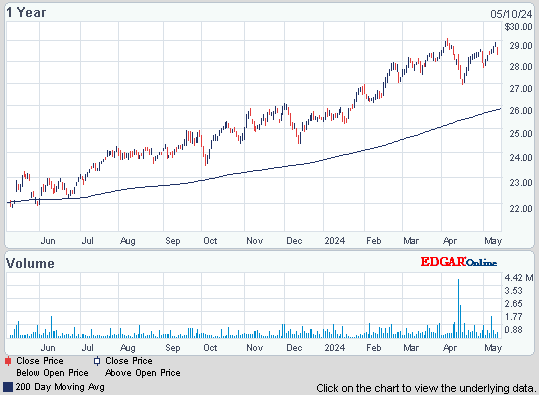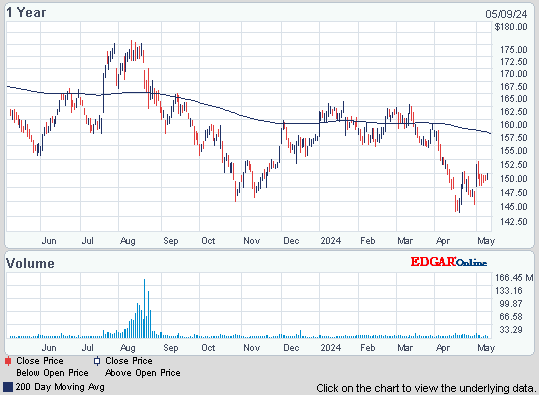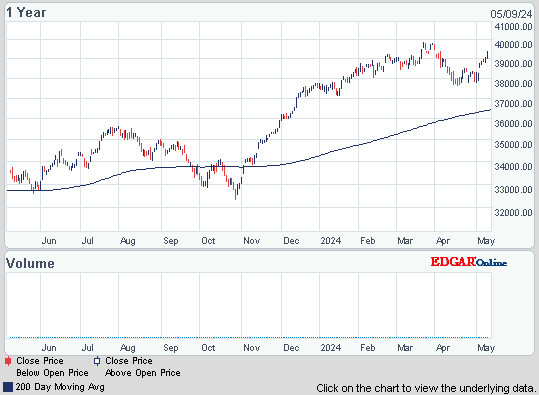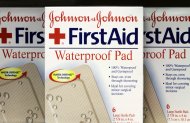Stocks never saw saw selling after the markets jumped at the opening. Dow finished up 194, advancers over decliners a more mild less than 4-1 & NAZ gained 54 (helped by Apple snapping back 29 following its recent sell-off). The MLP index recovered 3+ to 389 & the REIT index rose 2+ to 254 (within spitting distance of its yearly highs). Junk bond funds continued higher & Treasuries slipped back. Oil climbed to a 2-week high as Spain raised more than its maximum target at a debt auction & the IMF bolstered its global growth forecast. Oil has been drifting sideways for a few days (shown in the graph below).

![Live 24 hours gold chart [Kitco Inc.]](http://www.kitco.com/images/live/gold.gif)


Photo: Bloomberg
US factory production fell in Mar after companies made fewer electronic products, steel & other metals after 3 months of strong manufacturing gains. The Federal Reserve said that factory production dropped 0.2% last month. However in Q1, manufacturing output rose at an annual rate of 10.4% led by a nearly 40% increase production of motor vehicles & parts. Overall industrial production was flat in Mar, the 2nd straight month of no gain. A big 1.5% jump in output at utilities was offset by weakness in manufacturing. Output at the nation's mines edged up 0.2%. In recent months, factories are benefiting from rising consumer confidence & a better job market. Retail sales rose 0.8% in Mar. The gain capped a strong qtr for retail spending, which is contributing to a brighter outlook for growth in Q1. Businesses have responded to higher sales by restocking at a steady pace, a sign that they expect the trend to carry over into the spring.
Factories in U.S. Cool for First Time in Four Months: Economy
Photo: Yahoo
Johnson & Johnson, a Dow stock & Dividend Aristocrat, Q1 profit jumped 12.5% on lower spending on research, sales & administration & a boost from selling rights to a drug. But revenue slipped due to generic competition. JNJ said it will take longer than anticipated to return many recalled consumer products to stores & to rebuild a factory that made them because of serious quality problems there. Initially it said Tylenol, Motrin & other nonprescription drugs would all return to store shelves by mid-2012, but the latest delay pushes that back to well into next year. The costs to rebuild the factory, & for extra regulatory inspections of 2 others that make J&J's nonprescription drugs, are coming in higher than expected, although details were not given. Q1 EPS rose to $1.41 from $1.25 last year. Excluding costs related to the pending $21B acquisition of orthopedics device maker Synthes & a benefit from currency exchange rates, EPS was $1.37. Revenue dipped 0.2% to $16.1B. Expectations were for EPS of $1.35 on higher revenue of $16.3B. The company raised its annual profit forecast by 2¢ to $5.07-$5.17, excluding one-time items. Analysts are forecasting EPS of $5.11 for the year. The stock was up 16¢ on this muddy news, following little movement for many months.
Johnson & Johnson Increases Forecast as New Drugs Raise First-Quarter Net


Photo: Bloomberg
The number of home short sales surpassed foreclosure deals for the first time as banks became more agreeable to selling houses for less than the amount owed on their mortgages, according to Lender Processing Services. Short sales accounted for 23.9% of home purchases in Jan, the most recent month available, compared with 19.7% for sales of foreclosed homes. A year earlier, 16.3% of transactions were short sales & 24.9% involved foreclosures. “It’s a fairly recent phenomenon that short sales have been increasing,” Jonathon Weiner, a vice president in the applied analytics division of Lender Processing Services, said. “Short sales should be the dominant way of disposing of assets” in distress, he added. Lenders are catching up to short sales after being slow to provide the staffing & incentives necessary to complete the deals, Weiner said. The transactions typically fetch a higher price for banks than sales of homes that have gone thru foreclosure. In Jan, foreclosed homes sold for an average of 29% less than comparable non-distressed properties, compared with a 23% discount for short sales & the gap has narrowed as short sales become more common. The growing percentage of short sales, which don’t require going thru the drawn-out foreclosure process, is a sign that the US is making progress in working thru its inventory of distressed properties & the increase in short sales also may help values find a floor quicker. “Our baseline scenario is that home prices will hit a bottom at the end of this year,” he said. This a big part of the housing depression which has limited the economic recovery in the US & kept unemployment at high levels.
Home Short Sales Surpass Foreclosures in U.S. as Banks Approve More Deals
Today was the kind of day bulls like to see, with hardly a seller in sight. Earnings were good, Spain muddled by another another day when it sold bonds & Apple (AAPL) had a strong recovery. But European economic & debt problems have not gone away. The IMF is still forecasting flattish growth for the next couple of years. Spain has enormous problems, starting with extremely high unemployment. And some biggies were saying they're bearish on the € (around $1.31) which has been unable to find traction this year even with the best of news. But the bulls will point out the Dow had an impressive gain bringing it within 200 of its yearly highs. I worry about gas at the pump which remains above $3.90.

JPMorgan Chase Capital XVI (AMJ)
Click below for the latest market update:
Treasury yields:
U.S. 3-month | 0.076% | |
U.S. 2-year | 0.274% | |
U.S. 10-year | 2.003% |
| CLK12.NYM | ...Crude Oil May 12 | ...104.25 | ... 1.32 1.32 | (1.3%) |
![Live 24 hours gold chart [Kitco Inc.]](http://www.kitco.com/images/live/gold.gif)


US factory production fell in Mar after companies made fewer electronic products, steel & other metals after 3 months of strong manufacturing gains. The Federal Reserve said that factory production dropped 0.2% last month. However in Q1, manufacturing output rose at an annual rate of 10.4% led by a nearly 40% increase production of motor vehicles & parts. Overall industrial production was flat in Mar, the 2nd straight month of no gain. A big 1.5% jump in output at utilities was offset by weakness in manufacturing. Output at the nation's mines edged up 0.2%. In recent months, factories are benefiting from rising consumer confidence & a better job market. Retail sales rose 0.8% in Mar. The gain capped a strong qtr for retail spending, which is contributing to a brighter outlook for growth in Q1. Businesses have responded to higher sales by restocking at a steady pace, a sign that they expect the trend to carry over into the spring.
Factories in U.S. Cool for First Time in Four Months: Economy
Photo: Yahoo
Johnson & Johnson, a Dow stock & Dividend Aristocrat, Q1 profit jumped 12.5% on lower spending on research, sales & administration & a boost from selling rights to a drug. But revenue slipped due to generic competition. JNJ said it will take longer than anticipated to return many recalled consumer products to stores & to rebuild a factory that made them because of serious quality problems there. Initially it said Tylenol, Motrin & other nonprescription drugs would all return to store shelves by mid-2012, but the latest delay pushes that back to well into next year. The costs to rebuild the factory, & for extra regulatory inspections of 2 others that make J&J's nonprescription drugs, are coming in higher than expected, although details were not given. Q1 EPS rose to $1.41 from $1.25 last year. Excluding costs related to the pending $21B acquisition of orthopedics device maker Synthes & a benefit from currency exchange rates, EPS was $1.37. Revenue dipped 0.2% to $16.1B. Expectations were for EPS of $1.35 on higher revenue of $16.3B. The company raised its annual profit forecast by 2¢ to $5.07-$5.17, excluding one-time items. Analysts are forecasting EPS of $5.11 for the year. The stock was up 16¢ on this muddy news, following little movement for many months.
Johnson & Johnson Increases Forecast as New Drugs Raise First-Quarter Net
Johnson & Johnson (JNJ)

Photo: Bloomberg
The number of home short sales surpassed foreclosure deals for the first time as banks became more agreeable to selling houses for less than the amount owed on their mortgages, according to Lender Processing Services. Short sales accounted for 23.9% of home purchases in Jan, the most recent month available, compared with 19.7% for sales of foreclosed homes. A year earlier, 16.3% of transactions were short sales & 24.9% involved foreclosures. “It’s a fairly recent phenomenon that short sales have been increasing,” Jonathon Weiner, a vice president in the applied analytics division of Lender Processing Services, said. “Short sales should be the dominant way of disposing of assets” in distress, he added. Lenders are catching up to short sales after being slow to provide the staffing & incentives necessary to complete the deals, Weiner said. The transactions typically fetch a higher price for banks than sales of homes that have gone thru foreclosure. In Jan, foreclosed homes sold for an average of 29% less than comparable non-distressed properties, compared with a 23% discount for short sales & the gap has narrowed as short sales become more common. The growing percentage of short sales, which don’t require going thru the drawn-out foreclosure process, is a sign that the US is making progress in working thru its inventory of distressed properties & the increase in short sales also may help values find a floor quicker. “Our baseline scenario is that home prices will hit a bottom at the end of this year,” he said. This a big part of the housing depression which has limited the economic recovery in the US & kept unemployment at high levels.
Home Short Sales Surpass Foreclosures in U.S. as Banks Approve More Deals
Today was the kind of day bulls like to see, with hardly a seller in sight. Earnings were good, Spain muddled by another another day when it sold bonds & Apple (AAPL) had a strong recovery. But European economic & debt problems have not gone away. The IMF is still forecasting flattish growth for the next couple of years. Spain has enormous problems, starting with extremely high unemployment. And some biggies were saying they're bearish on the € (around $1.31) which has been unable to find traction this year even with the best of news. But the bulls will point out the Dow had an impressive gain bringing it within 200 of its yearly highs. I worry about gas at the pump which remains above $3.90.
Dow Industrials
Get your favorite symbols' Trend Analysis TODAY!



No comments:
Post a Comment